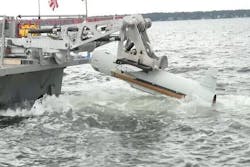Raytheon to help launch and recover counter-mine system that has imaging sonar and electro-optical sensors
WASHINGTON – Counter-mine experts at Raytheon Technologies Corp. will provide deploy and retrieve systems for the U.S. Navy AN/AQS-20 mine-hunting sonar system under terms of a $10.8 million contract announced Wednesday.
Officials of the Naval Sea Systems Command in Washington are asking the Raytheon Missiles & Defense segment in Portsmouth, R.I., to facilitate deployment and retrieval of AN/AQS-20 mine-hunting sonars.
The AN/AQS-20 is a mine-hunting and -identification system aboard the Navy's Littoral Combat Ship and Arleigh Burke-class destroyer. It has acoustic and identification sensors housed in an underwater towed body. The acoustic sensors detect, classify, and pinpoint bottom, close-tethered, and volume enemy mines in one pass.
The AN/AQS-20 uses imaging sonar, signal processing, electro-optical sensors, and computer algorithms to provide real-time, computer-aided detection and classification of threat mines. It automatically localizes mine-like objects and provides the operator with a visual image and a contact data list. All mission data is recorded for post-mission analysis.
In 2016, the Navy canceled the program after purchasing 10 systems, which are to be competed against the Textron Systems Fleet-class unmanned surface vessel system and the Knifefish unmanned underwater vehicle from the Bluefin Robotics segment of General Dynamics.
The AN/AQS-20A's combination of sidescan, forward-looking, and gapfiller sonars enables the system to detect and classify mine-like objects from the seafloor to the near surface in one pass.
Last year Raytheon won a $66.5 million contract to enhance the system's imaging sonar resolution by upgrading the 10 legacy AN/AQS-20A mine-hunting sonars to the AN/AQS-20C configuration.
While the legacy AN/AQS-20A has four separate sonars in a compact, lightweight and hydro-dynamically stable towed body, the AN/AQS-20C adds a fifth sensor -- a synthetic aperture sonar that provides the highest possible resolution for acoustic identification of underwater threats like submerged mines.
Related: Ocean mines have nowhere to hide
The AN/AQS-20 also has an electro-optical identification capability that delivers high-definition images of bottom mines using Streak Tube Imaging Laser technology. This provides the operator with range and contrast data for post-mission analysis to aid in mine identification. The system can find and neutralize sea mines placed as deeply as 450 feet deep.
It is a key element in single-sortie detect-to-engage capability, which combines the search, detect, identify, and neutralize elements of the Littoral Combat Ship's mine-countermeasures package.
The AN/AQS-20 completed developmental testing in February 2019, has been integrated aboard the Littoral Combat Ship. It is 10.5 feet long, 15.5 inches in diameter, and weighs 975 pounds.
In January 2020 Raytheon delivered its 10th and final AN/AQS-20 minehunting sonar system to the U.S. Navy. The sonar-towed body was transferred officially to the Naval Surface Warfare Center Panama City Division in Panama City, Fla.
For more information contact Raytheon Missiles & Defense online at www.raytheonmissilesanddefense.com, or Naval Sea Systems Command at https://www.navsea.navy.mil.
About the Author
John Keller
Editor-in-Chief
John Keller is the Editor-in-Chief, Military & Aerospace Electronics Magazine--provides extensive coverage and analysis of enabling electronics and optoelectronic technologies in military, space and commercial aviation applications. John has been a member of the Military & Aerospace Electronics staff since 1989 and chief editor since 1995.
